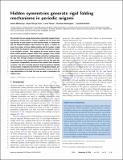Files in this item
Hidden symmetries generate rigid folding mechanisms in periodic origami
Item metadata
| dc.contributor.author | McNerney, James | |
| dc.contributor.author | Chen, Bryan Gin-ge | |
| dc.contributor.author | Theran, Louis Simon | |
| dc.contributor.author | Santangelo, Christian | |
| dc.contributor.author | Rocklin, Zeb | |
| dc.date.accessioned | 2021-05-15T23:49:45Z | |
| dc.date.available | 2021-05-15T23:49:45Z | |
| dc.date.issued | 2020-12-01 | |
| dc.identifier | 270577985 | |
| dc.identifier | f6ce4369-9a0c-423c-8a8b-c6c333ef143e | |
| dc.identifier | 85097210555 | |
| dc.identifier | 000596583400015 | |
| dc.identifier.citation | McNerney , J , Chen , B G , Theran , L S , Santangelo , C & Rocklin , Z 2020 , ' Hidden symmetries generate rigid folding mechanisms in periodic origami ' , Proceedings of the National Academy of Sciences of the United States of America , vol. 117 , no. 48 , pp. 30252-30259 . https://doi.org/10.1073/pnas.2005089117 | en |
| dc.identifier.issn | 0027-8424 | |
| dc.identifier.other | ORCID: /0000-0001-5282-4800/work/90952185 | |
| dc.identifier.uri | https://hdl.handle.net/10023/23195 | |
| dc.description | Funding: NSF Award No. PHY-1554887 (B.G.C.). NSF DMR-1822638 (C.S.). Georgia Institute of Technology President’s Fellowship and the STAMI Graduate Student Fellowship ( J.M.). | en |
| dc.description.abstract | We consider the zero-energy deformations of periodic origami sheets with generic crease patterns. Using a mapping from the linear folding motions of such sheets to force-bearing modes in conjunction with the Maxwell–Calladine index theorem we derive a relation between the number of linear folding motions and the number of rigid body modes that depends only on the average coordination number of the origami’s vertices. This supports the recent result by Tachi [T. Tachi, Origami 6, 97–108 (2015)] which shows periodic origami sheets with triangular faces exhibit two-dimensional spaces of rigidly foldable cylindrical configurations. We also find, through analytical calculation and numerical simulation, branching of this configuration space from the flat state due to geometric compatibility constraints that prohibit finite Gaussian curvature. The same counting argument leads to pairing of spatially varying modes at opposite wavenumber in triangulated origami, preventing topological polarization but permitting a family of zero-energy deformations in the bulk that may be used to reconfigure the origami sheet. | |
| dc.format.extent | 7703291 | |
| dc.language.iso | eng | |
| dc.relation.ispartof | Proceedings of the National Academy of Sciences of the United States of America | en |
| dc.subject | Origami | en |
| dc.subject | Mechanisms | en |
| dc.subject | Rigid folding | en |
| dc.subject | Topological polarization | en |
| dc.subject | QA Mathematics | en |
| dc.subject | T Technology | en |
| dc.subject | T-NDAS | en |
| dc.subject.lcc | QA | en |
| dc.subject.lcc | T | en |
| dc.title | Hidden symmetries generate rigid folding mechanisms in periodic origami | en |
| dc.type | Journal article | en |
| dc.contributor.institution | University of St Andrews. Pure Mathematics | en |
| dc.identifier.doi | 10.1073/pnas.2005089117 | |
| dc.description.status | Peer reviewed | en |
| dc.date.embargoedUntil | 2021-05-16 |
This item appears in the following Collection(s)
Items in the St Andrews Research Repository are protected by copyright, with all rights reserved, unless otherwise indicated.

